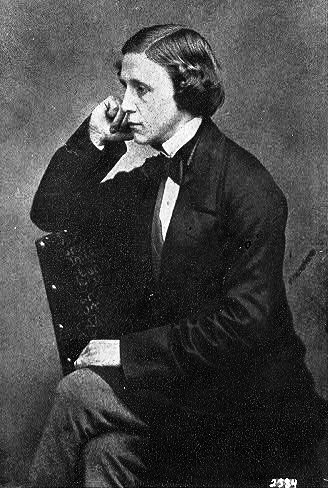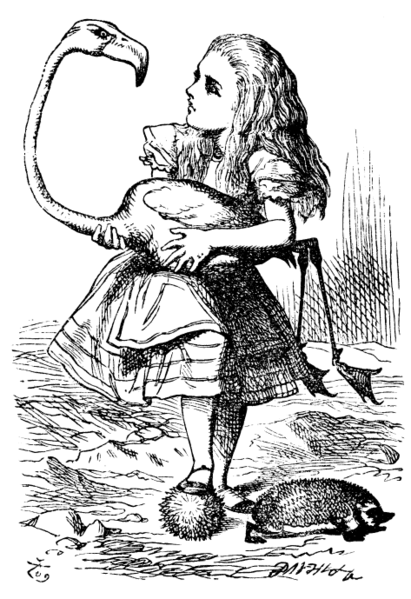Dodgson’s Dogged Determination or a Coincidence?
It is well known both that Tennyson had many famous visitors at Farringford and that the Reverend Charles Dodgson, or Lewis Carroll, was amongst them. When he was young, Dodgson had a great passion for Tennyson’s poems and he longed to meet the great poet.
Meeting in the Lake District
 This week I have been reading a book called Lewis Carroll: An Illustrated Biography by Derek Hudson, in which he writes that Dodgson, ‘by accident or design’, met the Tennysons when they were staying at Tent Lodge in the Lake District in the summer of 1857 (p. 95). Tent Lodge, incidentally, is where the Tennysons had spent part of their honeymoon in 1850. Dodgson either heard they were in the neighbourhood, or came there himself on purpose to meet Tennyson; either way he smoothed the way to introducing himself by leaving a visiting card that reminded them that he had sent them a photograph of Agnes Grace, Emily’s sister’s daughter (p. 95). When he finally paid the visit, Alfred was away, but Emily made him welcome.
This week I have been reading a book called Lewis Carroll: An Illustrated Biography by Derek Hudson, in which he writes that Dodgson, ‘by accident or design’, met the Tennysons when they were staying at Tent Lodge in the Lake District in the summer of 1857 (p. 95). Tent Lodge, incidentally, is where the Tennysons had spent part of their honeymoon in 1850. Dodgson either heard they were in the neighbourhood, or came there himself on purpose to meet Tennyson; either way he smoothed the way to introducing himself by leaving a visiting card that reminded them that he had sent them a photograph of Agnes Grace, Emily’s sister’s daughter (p. 95). When he finally paid the visit, Alfred was away, but Emily made him welcome.
Unsurprisingly for the future author of Alice in Wonderland, Lionel and Hallam were quite taken with this new visitor. Dodgson was an avid amateur photographer and he acquired permission from Emily to return to photograph the boys.
On his return, Dodgson finally met Tennyson and the two men discussed passages of ‘Maud’ that Dodgson had found troubling. Dodgson was so well received in the Tennyson household that he returned again and ‘took several photographs of Tennyson and his family—Tennyson coming out very dark and swarthy, like a Velasquez self-portrait’ (p. 96).
This series of visits does not quite justify the title of this blog. Surely meeting the Tennysons and returning to their lodgings, by invitation, does not deserve to be called doggedness. However, taken together with Dodgson’s chance meeting with Tennyson when he was at home, at Farringford, there begins to be a sense of pursuit.
Meeting at Farringford
In 1859, Dodgson visited the Isle of Wight. In later years, he would often come to stay at Holly Tree Cottage next to Myrtle Cottages where William Allingham stayed and across the road from Whitecliff house where Alice Liddell stayed with her family ( see pictures of both cottages and the house). During his 1859 visit, he just happened to be walking toward Farringford one day while Tennyson was out mowing the grass. Though Dodgson ‘denied that he had “followed the Laureate down to his retreat”’ (Hudson, p.96), I’m not convinced this meeting was purely coincidental.
Mathematician, Amateur Photographer, and Writer
 To a twenty-first century audience it may be surprising that when Tennyson met with Dodgson in his grounds at Farringford, after recovering from the surprise and irritation of the unexpected visit and finishing his mowing, he remembered him as a photographer (Hudson, p. 96), but we must remember that he wasn’t to publish Alice’s Adventures in Wonderland until 1865. It is less surprising that Tennyson didn’t associate his visitor with mathematics because it is unlikely Tennyson kept up with reading the latest publications on mathematics and statistics, though Dodgson was prolific in this kind of work.
To a twenty-first century audience it may be surprising that when Tennyson met with Dodgson in his grounds at Farringford, after recovering from the surprise and irritation of the unexpected visit and finishing his mowing, he remembered him as a photographer (Hudson, p. 96), but we must remember that he wasn’t to publish Alice’s Adventures in Wonderland until 1865. It is less surprising that Tennyson didn’t associate his visitor with mathematics because it is unlikely Tennyson kept up with reading the latest publications on mathematics and statistics, though Dodgson was prolific in this kind of work.
It is just possible that had Dodgson gained literary fame before his encounters with Tennyson, he might have been more sensitive to the poet’s desire for privacy. Dodgson, very much like Tennyson, loathed the fame that came along with his success. As it stands, however, it seems that Dodgson’s approach to his relationship with the Laureate proved to be its undoing.
The End of a Young Friendship
From 1859 to 1870 Dodgson went on meeting with the Tennysons on occasion. He shared his poetry with the children and seemed to be welcome when he visited. In 1870, however, that was all to change.
Tennyson, throughout his career, was understandably protective of poems he chose not to publish. He was also easily irritated by people writing to him with what he perceived to be rude or silly requests. So, when Dodgson wrote to Tennyson on 3 March 1870 to ask permission to read a manuscript copy of the then unpublished ‘The Window’ that had come into his hands, the poet was annoyed. Emily responded to the letter, closing it with the following statement:
‘It would be well that whatever may be done by such people [referring to those who circulate manuscript copies of unpublished works] a gentleman should understand that when an author does not give his works to the public he has his own reasons for it’ (Hudson, p. 98).
Dodgson was understandably hurt by this reply and the implication that he has behaved in an ungentlemanly manner, so he, assuming the sentiment expressed in Emily’s letter is Tennyson’s, addressed his reply to the Laureate. This letter was to start an exchange of terse replies that would, sadly, spell the end of their friendship.
What are your favourite books by Lewis Carroll? Have you read a biography of Dodgson that might shed further light on his relationship with Tennyson than what I’ve read in Hudson’s?